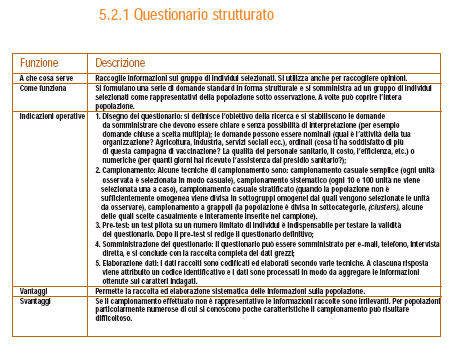
Data collection methods
How do we Evaluate Programmes?
Standard Evaluation methods
A good project / programme design will consider how to monitor and evaluate during and after the implementation phase (in itinere and ex post). It will therefore decide what are the indicators and what are the sources of information for judging the efficiency, the effectiveness and the impact.
Information sources may be independent from the programme/project management team and the organization. Others will be the internal evaluation tasks that will collect data concerning processes and outcomes.
Programme/project designers will consider the standard methods of collecting and analyzing data and will adopt those that are seen as most suitable. Eventually a new approach may be proposed. After deciding on the method there will be an illustration of the evaluation activity within the program/project, including the indications regarding how to use the monitoring/evaluation results for improved programme/project management, for organizational development and for employee empowerment and leaning. (see evaluation reporting methods; and methods for generating acceptance for the evaluation reports).
-----
The approach and methods used in an data collection method will be determined by the reasons for which it is being undertaken, who is taking responsibility and who needs to be involved.
For an efficient management of evaluation action it is important to avoid collecting data for purely reporting purposes: it is important to focus those elements on the bases of which one can make managerial decisions and/or learn if the previous decisions were appropriate.
It is very important to link evaluation of managerial processes with the evaluation of the programme/project outcomes. For a manager to learn means to understand the relationship between processes and outcomes since s/he can achieve outcomes only by improving the management of processes. Although there are different indicators and different information sources for monitoring and evaluating processes (efficiency, accountability and transparency , etc.) and outcomes (effectiveness, sustainability, impact), real understanding can be done only integrating the two dimension in a unitary vision of necessary relationship amongst resources, activities, results, objectives and impacts. The central element is always the empowerment of the human resources to do actions in a better way so as to achieve better results and obtain better outcomes.
Whatever be the budget for data collection one should never go into a data collection exercise that cannot lead to improved learning and improved decision making. So it is wrong to collect more information than the capacity or the scope to analyse, organise and utilize.
In all the method of data collection one should consider the principles of sampling.
Standard collecting methods include:
surveys -
questioning - through questionnaires; interviews,
Vrinda here please re-write the following para to keep them logically related to the lines above also verify the coherence with the links above.
In general, the overall approach and methods selected for an evaluation should involve beneficiaries and the other relevant stakeholders in the design and implementation of the evaluation. (see Stakeholders Identification - Involving Stakeholders ; Participation Methods and Tools)
The use of secondary data, such as official statistics and data from the monitoring system to support more qualitative data also needs to be considered.
What information should you collect? Besides classifying the date in this way one should say what different usages are these cathegiories for ... less shoulds and more can or will
Qualitative and Quantitative Research Methods
Here there is a problem to be discussed: Qualitative can be done only on quantitative ... like evaluation can be done only on monitoring. Indicators are always "quantitative" parameters that "indirectly" and "within a constellation" give clues upon which to have qualitative judgments. Like for instance asking opinions can be defined as "qualitative" ... but in fact we group opinions as "percentages" of people and characterize them into groups (so we have quantitative figures about opinions). Another issue instead is to ask people to join the evaluation process by expressing their judgments ... still we need to be sure that these judgments are well ground on monitoring and indicators .... So we can never have a "purely qualitative" judgments. Nor a purely "quantitative" since the very choice of what quantitative indicators to select is not a qualitative-based choice.
Here below the "common sense" classifications commonly used according to which :There are two basic types of research you might conduct with intended audiences: qualitative and quantitative. You will use methods from one of these two types depending upon what you want to learn. See the sidebar below, Qualitative Versus Quantitative Methods, for common distinctions between qualitative and quantitative research.
| Qualitative Versus Quantitative Methods | |
| Qualitative | Quantitative |
| Provides depth of understanding | Measures level of occurrence |
| Asks "Why?" | Asks "How many?" and "How often?" |
| Studies motivations | Studies actions |
| Is subjective; probes individual reactions to discover underlying motivations | Is objective; asks questions without revealing a point of view |
| Enables discovery | Provides proof |
| Is exploratory | Is definitive |
| Allows insights into behavior and trends | Measures levels of actions and trends |
| Interprets | Describes |
| Note. From Methodological Review: A Handbook for Excellence in Focus Group Research by M. Debus. Copyright 1988 by The Academy for Educational Development, Washington, DC. Reprinted with permission. | |
Other resources: IPDET - data collection methods
-------------
EU resources

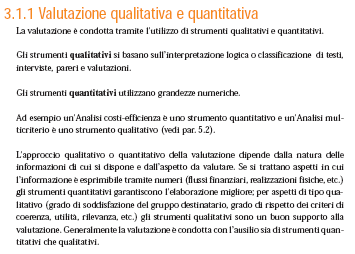
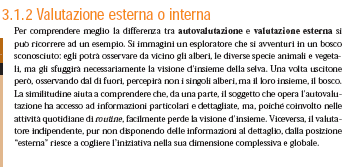
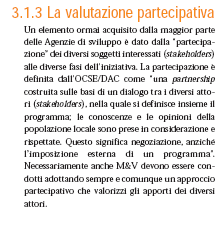
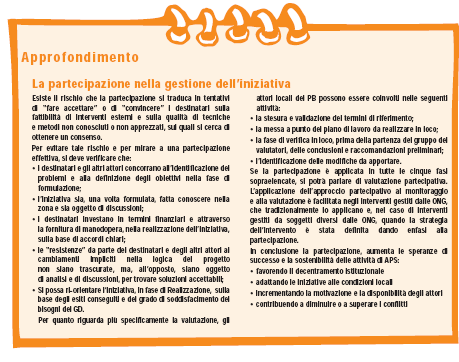
See aslo
What is participation - Partecipazione come concertazione allargata
The Six Steps in the partnership process
Participatory Planning and Decisionmaking
Partecipation Methods and Tools
Introduction Methods and Tools
Appreciation-Influence-Control (AIC)
-----------------------
See also: The Strategy Challenges
Communication and Knowledge Management
-------------
EU resources